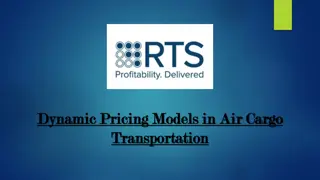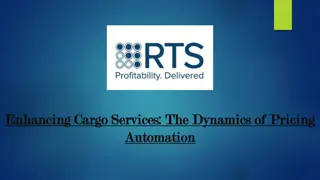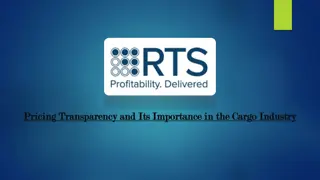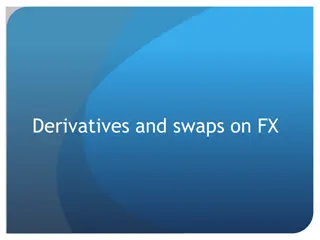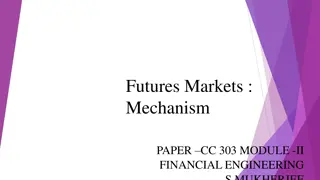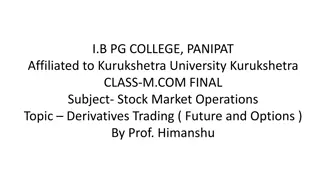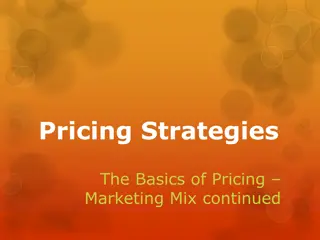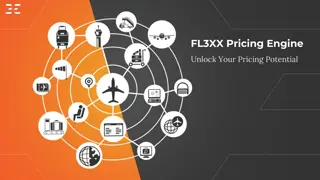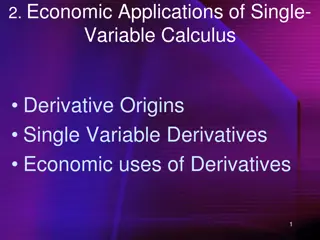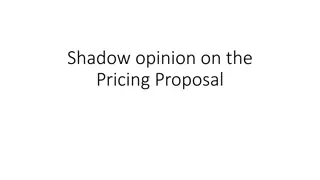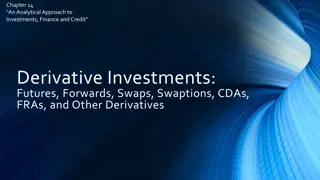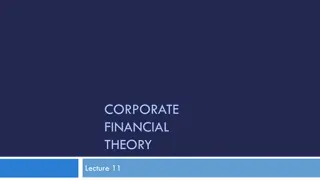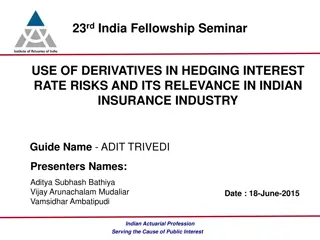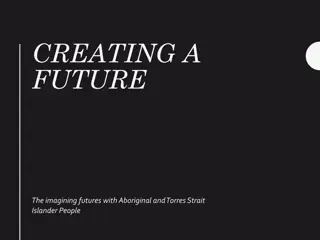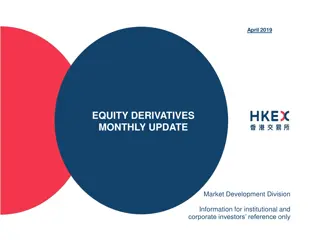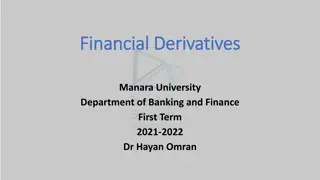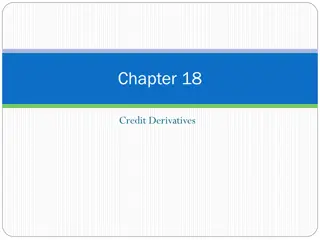Understanding Forward and Futures Pricing in Financial Derivatives
Explore the concepts of forward and futures pricing in financial derivatives, including scenarios on asset valuation, property investment, and art piece acquisition. Learn about contracts with no income, constant income, and lumpy income, along with relationship equations involving spot prices, interest rates, and forward dates.
Download Presentation

Please find below an Image/Link to download the presentation.
The content on the website is provided AS IS for your information and personal use only. It may not be sold, licensed, or shared on other websites without obtaining consent from the author. Download presentation by click this link. If you encounter any issues during the download, it is possible that the publisher has removed the file from their server.
E N D
Presentation Transcript
Forward pricing: Some prelims Forward contracts on assets that 1.Pay no income 2.Pay a lumpy income 3.Pays continuously Financial Derivatives 2
Forward pricing: Some prelims Pay no income Easiest type of contract to value: Underlying asset has no intermediate cash flows. Financial Derivatives 3
Forward pricing: Some prelims Two ways to own an art piece at time T: Buy it today Go long a forward contract that expires at T Both ways should cost the same today. Assuming no benefits Financial Derivatives 4
Forward pricing 1. You want to present your spouse a painting on his/her birthday 1 yr from now. Suppose an art dealer offers to sell you a painting today for INR 100,000 or INR 120,000 in one year s time. Would you buy it today or in one year?? (assume your banker will pays/finance it at 10%) 2. Suppose an art dealer offers to sell you a painting today for INR 100,000 or INR 108,000 in one year s time. Would you buy it today or in one year?? (assume your banker will pays/finance it at 10%) Financial Derivatives 5
Forward pricing 3. Now suppose you have an opportunity to buy a property worth INR 1Mn now or at INR 1.1 Mn after one year. The property can be leased at INR 220,000 pa (payable at the end of the year). Our banker will finance at 15%. Financial Derivatives 6
Some relationships So an asset that pays no income F= r.t S x e F = forward price S = spot price r = int. rate to fwd date t = no. of days to fwd expiry Financial Derivatives 7
Some relationships an asset that pays constant income F= (r - q).t S x e F = forward price S = spot price r = int. rate expressed as % pa t = no. of days to fwd expiry q = asset income expressed as % pa Financial Derivatives 8
an asset that pays lumpy income ( ) = . re t ( ) F S PV Divs F = forward price S = spot price r = int. rate expressed as % pa t = no. of days to fwd expiry Financial Derivatives 9
Our learning Replication Fair price Interest effect Income effect interest paid income recd. The relationship between Forwards and spot Fwd. Price = spot price + cost of carry Any violations??? Financial Derivatives 10
Violations Price a 4-month forward contract on a non- dividend paying stock with following data: Stock price = Rs. 130 interest rate = 6% The theoretical price of the forward contract on a financial asset that pays no income: F0,t = S0ert Financial Derivatives 11
Cash and carry arbitrage This gives us a forward price of Rs. 132.6 What if F0,4/12 = Rs. 135 rather than Rs. 132.6? Free lunch!! Today: Borrow 130 at a rate of 6% (will owe Rs. 132.6 in 4 months). Buy stock for Rs. 130. Short a 4-month forward contract at Rs. 135. WAIT 4 MONTHS! Financial Derivatives 12
Cash and carry arbitrage 4 months later: Deliver stock under forward contract at Rs. 135 Repay loan of Rs.132.6 Keep the profit of Rs. 2.4 (135 -132.6) Financial Derivatives 13
Reverse cash and carry arbitrage What if the fwd is available at 129.95 rather 132.63? See whether you arrive at a minimum arbitrage profit of Rs. 2.65. Financial Derivatives 14
Cash and carry arbitrage 1 Borrow money to buy shares 2 Buy the shares Today 3 Simultaneously sell forward contract 4 Hold shares 5 Deliver shares as fulfillment of fwd. obligation and FWD expiry day collect money = Fwd price 6 Repay the loan along with interest Financial Derivatives 15
Reverse cash and carry 1 Sell shares short 2 Lend proceeds from sale 3 Simultaneously buy the forward contract Today 4 Wait until expiry 5 Encash the deposit, 6 Pay the money under fwd. take delivery of shares from fwd counterparty FWD expiry day 7 And deliver these shares against the short sale Financial Derivatives 16
Arbitrage Steps Compute the fair forward price that can be replicated in the cash market ( Asset + Borrowing) Compare the fair forward price with market price of the forward IF FWDm < FWDF Market price of fwd < fair fwd price -------- Reverse Cash & Carry Arb Financial Derivatives FWDm > FWDF 17
Fwd Pricing Philosophy Preclude Arb Opps Financial Derivatives 18
Is there an Arb oppty? 4. Spot gold sells for $600/oz. You can risklessly borrow or lend any amount of money at an annual rate of 10%. What is the forward price of gold that calls for delivery of 100oz. of gold 5 months from today? Suppose that F = $627/oz. Explain how you would arbitrage. 5. Spot gold sells for $600/oz. You can risklessly borrow or lend any amount of money at an annual rate of 10%. What is the forward price Financial Derivatives of gold that calls for delivery of 100oz. of gold 5 months from today? Suppose that F = 19
Value of a forward prior to maturity Let S0 = 400; t = 1; r = 10%. Now consider six months have gone by and the spot rate is 450 other things remaining the same. Is the old forward an asset or liab for the buyer? seller? Financial Derivatives 20
But in practice Absence of perfect markets Differential lending and borrowing rates Restrictions on short sales The net effect of all these complexities is that there will be a band around fair value within which arbitrage will not be profitable Financial Derivatives 21
CC, RCC with imperfections 6. Assume 1% transaction costs (only in spot market) in Q. No. 4 and determine whether there is an arbitrage opp? 7. Assume 50% short-sale proceeds in Q. No. 5 and determine whether there is an arbitrage opp? Financial Derivatives 22
In summary The net effect of all these complexities is that there will be a band around fair value within which arbitrage will not be profitable CC Arb RCC Arb Financial Derivatives 23
Value of a Fwd Contract If one already holds a position, valuation means the amount of money one would either have to pay or expect to receive in order to get out of the position. Financial Derivatives 24
Example Suppose you entered in to a fwd contract on Dec 1 2009 to buy Crude oil at $75/bbl on Jan 28, 2010. On Jan 28, 2010 if the spot price of crude oil is $78/bbl your forward contract is worth/value $3/bbl. In other words $3 is the value of contract. At expiry (T) value of the forward is given as: VT = ST - F Financial Derivatives 25
Example 8. Suppose you buy a one-year forward contract at $65. At expiration, the spot price is $73. The risk-free rate is 10 percent. What is the value of the contract at expiration? Financial Derivatives 26
Value of the Fwd contd.. What is the value of the fwd at inception? What is the value of the Fwd at any other point of time prior to expiry? Financial Derivatives 27
Value of the Fwd contd.. 9. Suppose you bought a three-month forward contract at $35. One month later, new forward contracts are selling for $40. The risk- free rate is 10 percent. What is the value of your contract? Financial Derivatives 28
Forwards and Futures So far we had not distinguished between futures pricing and fwd pricing Do futures prices equal fwd prices? Consider the case of copper futures traded on LME CF = futures Time Futures price Gain/Loss X C o n t r a c t s i z e 0 1 2 3 4 5 7300 7305 7312 7315 7308 7315 5 7 3 125 175 75 -175 175 375 -7 7 Financial Derivatives 29
Forward Price at expiry Distinction between Price and Value
Legal aspects... Governed by SC(R) Act, 1956, the SEBI Act, various rules, regulations and bye laws of the concerned exchanges Financial Derivatives
Legal framework SCRA, 1956 Act does not include derivatives as securities Indian Contracts Act 1872 Financial Derivatives
Legal framework contd Securities Laws (amendment) Act, 1999 The derivatives formally defined under the said Act, 1999 include A security from a debt market, share, loan, risk instrument or contract for differences or any other form of security And . A contract which derives its value from the prices or index of prices underlying securities Financial Derivatives
Legal framework contd The Act also clarified that not with standing in any other law for the time being in force, contracts shall be legal and valid only if such contracts are traded on a recognized exchanges in accordance with the rules and bye laws of stock exchange, thus precluding Financial Derivatives OTC derivatives .
Legal framework contd March 1, 2000 Notification The contracts for sale and purchase of Gsecs, securities related to gold, money market securities and debt market related securities will be regulated by RBI Such securities if traded on stock exchanges will be regulated by SEBI Financial Derivatives
Provisions affecting legality of OTC deri.. Section 30 of Contracts Act, 1872 which renders all wagering contracts as unenforceable and void. Section 2(aa) of Securities Contract (Regulation) Act, 1956, defining derivatives and Section 18A of Securities Contract (Regulation) Act, 1956 which makes only the exchange traded derivatives legal. Financial Derivatives


